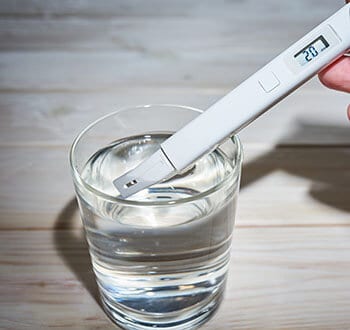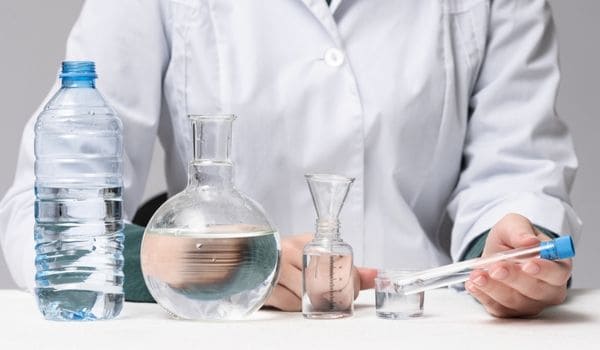
A TDS meter is a small, handheld digital device that measures the concentration of total dissolved solids (TDS) in water. These solids — including minerals, salts, and metals — affect the water’s electrical conductivity, which the meter reads and converts into a parts-per-million (ppm) value.
What a TDS meter can do:
- Measure total dissolved solids in drinking water
- Help monitor the performance of water filters
- Indicate potential water hardness issues
- Detect sudden changes in water quality over time
💡 Quick Tip: A TDS meter won’t identify specific contaminants or confirm if water is safe to drink — it simply shows how much dissolved “stuff” is in it.
A TDS meter won’t give you a full lab report — but for under $20, it’s one of the fastest ways to get a feel for your water quality.
📌 Key Takeaways
- 💧 Best used as a first step — not a replacement for full water testing
- 📏 TDS = Total Dissolved Solids, measured in parts per million (ppm)
- ⚡ TDS meters work by measuring electrical conductivity in water
- 🚱 High readings may indicate contamination or hard water issues
- 🧪 TDS meters don’t detect lead, PFAS, bacteria, or pesticides
- 🔁 They’re useful for checking filters, aquariums, wells & garden water
📏 What Does a TDS Meter Actually Measure?
TDS stands for Total Dissolved Solids — the invisible stuff in your water that you can’t see, but might still taste. That includes minerals like calcium and magnesium — but also trace metals, salts, and other tiny charged particles smaller than 2 microns.
Anything larger than that is considered Total Suspended Solids (TSS) — and if you’re using a water filter, the difference matters when choosing a micron rating.
Most dissolved solids come from natural sources like rocks and soil, but they can also enter water through plumbing, road salt, fertilizers, or runoff from industrial sites.
💡 Helpful to know:
A TDS meter measures total solids — but not specific ones. Think of it like stepping on a scale: it tells you your total weight, not what’s fat, muscle, or water.
⚖️ Are Total Dissolved Solids Safe?

TDS levels in your water don’t automatically mean danger — in fact, some dissolved solids are beneficial. Minerals like potassium, magnesium, and calcium are part of a healthy drinking water profile. But when TDS levels creep too high, they can signal a bigger problem hiding beneath the surface.
Here’s a quick breakdown of what different TDS levels mean:
| TDS Level (mg/L) | What It Means |
|---|---|
| 💧 0–300 | Excellent — clean water with a balanced mineral profile |
| 😐 301–600 | Good — safe to drink, though taste may vary |
| 😬 601–900 | Fair — may taste bitter or metallic, time to investigate |
| 🚩 901–1200+ | Likely contaminated — avoid drinking until tested |
Keep in mind, the EPA doesn’t set a legal limit for TDS, only a recommendation of 500 mg/L. Water above that isn’t necessarily dangerous, but it might be unpleasant — and it could be carrying contaminants you can’t detect with a TDS meter.
🧠 Helpful to know:
High TDS doesn’t always mean toxic — and low TDS doesn’t always mean safe. You’ll need a full water test to find out what’s really in your water.
⚡ How Do TDS Meters Work?

TDS meters don’t scan your water for toxins — they measure electrical conductivity. Pure water doesn’t conduct electricity well, but dissolved solids (like salts and minerals) do. The more solids in your water, the more conductive it becomes — and the higher the TDS reading.
Think of it like a rough estimate of “how much stuff” is floating in your glass.
But here’s the catch:
🧪 TDS meters can’t tell you what the solids are — just that they’re there.
They can’t detect uncharged particles like:
- Lead
- PFAS
- Pesticides
- Petroleum-based chemicals
- Bacteria or pharmaceuticals
That’s why a high reading means “something’s off” — but a low one doesn’t guarantee safety either.
⚠️ Helpful to know:
Using a TDS meter is a great first step — especially if you’re monitoring reverse osmosis or softener performance — but it should never replace full lab testing if you suspect contamination.
🧠 What TDS Readings Actually Tell You About Your Water

A TDS meter gives you a quick pulse check on your water — but knowing what the number means is what makes it useful. Here’s how to read it like a pro:
- Readings below 300 ppm usually mean your water is clean, crisp, and mineral-balanced
- Readings above 500 ppm might taste off, and could be carrying unwanted minerals or salts
- Above 900 ppm? Something’s wrong — and you should follow up with a proper test
But remember: a TDS meter won’t flag bacteria, heavy metals, or PFAS. If your water smells strange, suddenly tastes different, or you’re in a high-risk area, don’t rely on that reading alone.
💡 Helpful to know:
Many cities publish average TDS readings for their water supply. Use that as a benchmark — if your TDS reading suddenly spikes 200+ ppm higher than the usual report, something’s changed and it’s worth digging into.
🔍 Are High TDS Readings a Reason to Filter Water?

Not always — but sometimes. High TDS isn’t automatically a health threat, but it can be a red flag for other issues like limescale, bitter taste, or unwanted contaminants. It all depends on what’s behind the number.
| Possible Cause | What You Might Notice | Best Fix |
|---|---|---|
| 🧂 Hard minerals (like calcium, magnesium) | Bitter taste, limescale on fixtures | Water softener or RO system |
| 🛢️ Road salt, fertilizer, runoff | Spikes in winter or after rain | Whole-house carbon or RO filter |
| 🥄 Natural salts in well water | Slick feel, salty aftertaste | Reverse osmosis or deionization system |
| 🚰 Old plumbing or corroded pipes | Metallic taste, staining, high TDS | Point-of-use filter + pipe inspection |
| 🧼 Residual disinfectants from treatment | Chemical taste, higher TDS after main breaks | Carbon filter to polish municipal water |
Even if your water is technically safe to drink, high TDS levels can mess with your appliances, your taste buds, and your peace of mind. If your reading is unusually high — or just climbing over time — it’s probably time to upgrade your filtration setup.
🔎 Helpful to know:
Some minerals in water are good. In fact, many health experts prefer a small amount of dissolved solids over ultra-purified water with nothing in it. If your TDS is between 100–300 ppm and the water tastes great — you’re probably in the sweet spot.
🛒 Should You Buy a TDS Meter?

A TDS meter won’t replace a full lab test — but it’s still one of the smartest under-$20 tools you can have around the house. Think of it as your water quality cheat code: quick, portable, and great for catching changes before they become big problems.
✨ When a TDS Meter Comes in Handy:
- 🧪 Checking your filtration system: Use it before and after your RO system or softener to make sure it’s still doing its job
- 🐠 Maintaining aquariums: Monitor dissolved minerals to keep your tank balanced and your fish stress-free
- 🌿 Watering plants or gardens: Some plants thrive with higher TDS — others don’t. It’s good to know
- ⛲ Well monitoring: If you have a shallow well or live in a flood-prone area, use it after big storms
- 🔁 Municipal water changes: After a water main break or service disruption, test for spikes in solids
- 💡 Everyday peace of mind: Sometimes it’s just nice to know what’s in your glass
🧠 Helpful to know:
TDS meters don’t last forever. If yours is more than two years old — or if it seems inconsistent — it’s probably time for an upgrade. Look for digital models with temperature compensation for more accurate readings.
You can buy the one we tested on Amazon for under $15 bucks. See it here
🚨 What To Do If You Suspect Contamination

Here’s what to do next:
- 🚿 Use caution with bathing — for most situations, it’s safe to shower, but avoid hot water if you suspect VOCs or other vapor-sensitive compounds
- 🚫 Stop drinking it — switch to bottled for now, especially if you have infants, pets, or immune concerns
- 🧪 Schedule a full water test — you can send a sample to a certified lab, or grab a reliable DIY test kit
- 🧼 Use filtered water for cooking — even if the water is “technically” safe, boiling won’t remove many contaminants
- 🔧 Check your plumbing — old pipes can release metals that increase TDS levels and taste weird
🧠 Helpful to know:
If you use well water, a sudden TDS spike after heavy rain or flooding could mean surface water entered your system. You’ll want to rule out bacteria, especially coliform — this guide can help you figure out what to test for first.
🧪 Choosing a Water Test That Makes Sense

A TDS meter is a great first step — but when you need real answers, a proper water test is the only way to know what’s really in your tap. Testing doesn’t have to be expensive, but it should be strategic.
🧠 Here’s how to choose the right test:
- 🏙️ Municipal water? Test for chlorine, fluoride, disinfectant byproducts, and emerging contaminants like PFAS
- 💧 Private well? Look for bacteria, nitrates, metals, and pH. Well testing guides can help you focus based on where you live
- 🧾 On a budget? Choose a kit that targets the most likely risks based on your source and location — you don’t need to test for everything
- 🏷️ Want peace of mind? Certified lab kits may cost more upfront but give you personalized results and treatment recommendations — no guesswork
🧼 Helpful to know:
If your water looks fine but your TDS reading is high, don’t assume the worst. You might just have elevated minerals. But if your TDS is low and you still notice weird smells, metallic taste, or health symptoms? Get a test — TDS meters won’t catch bacteria or chemicals that don’t carry a charge.
✅ Final Thoughts
A TDS meter won’t solve all your water problems — but it’s a smart, affordable tool that gives you a fast look at what’s happening below the surface. Whether you’re testing a reverse osmosis system, checking your well after a storm, or just curious what’s in your glass, it puts knowledge (literally) in the palm of your hand.
It’s not a replacement for full testing — and it won’t detect every threat. But it’s a solid first step toward better water habits and safer sips.
So grab a meter, take a reading, and let that number guide your next move.
Because when it comes to clean water, knowing is always better than guessing.
 194 people found this helpful. Was this guide helpful to you?
194 people found this helpful. Was this guide helpful to you? 


